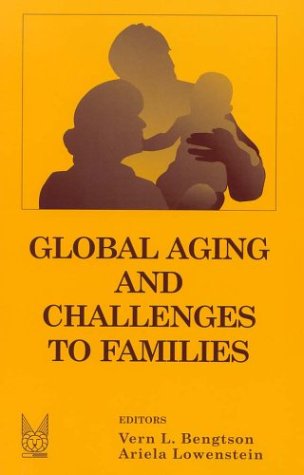Global Aging and Challenges to Families
Bengtson, Vern L. and Ariela Lowenstein (Editors)
Aldine de Gruyter, New York
2003
0202306879

This volume examines the consequences of aging populations for support to the elderly from families or from public service systems. Most of the authors, especially those from Israel, Germany, Spain, the UK and Norway, collaborated in a research project funded by the European Commission. Some American authors contributed studies supported by the US Institute on Aging. Others report on similar issues in France, Ghana, Japan, Korea, and the Netherlands. Of course, the risk of failing to address these issues from a coherent perspective is enormous with 35 authors from ten very different countries. Still, perhaps only with some minor exceptions, the result of the editors' work is remarkable, making the volume a well-structured, informative and pleasant read.
The book has five sections preceded by an opening chapter offering a quick statistical overview on aging worldwide and a general introduction of the central question of the book: can families take 'care of the growing number of tomorrow's very old members of societies'?
Section one covers the role of intergenerational social support in 'multiple contexts', (in contexts that are not restricted to one particular society). The central message is that the two-sided aging process (more elderly and more very old people) worldwide might hamper solidarity and support transfers between different generations within families. The chapter on the possible rise of personal communities is noteworthy, especially considering the dominant genealogical perspective on generations in this volume. Today people have a much wider social circle (partly resulting from more changes in the life course; with divorce, e.g., the number of 'family members' increases) and research should more focus on this. This chapter underlines the importance of taking a broader view on generations including not only genealogical generations, but also more sociological (Mannheimian) generations: different birth cohorts who feel connected based on a common history and destiny. Today's baby boomers and thus tomorrow's elderly will no doubt aim to uphold different lifestyles compared to today's elderly, demand different types of care from different social circles, and create new dependencies and transfer routines between generations. These prospects favour a broader view on generations than 'just' a genealogical one.
Section two covers the same issues within specific contexts, being Germany (on motives for transfers within family generations), the Netherlands (on loneliness and family characteristics), and Israel (changes in commitment across the life span). The latter chapter is a hard read in between the more matter-of-fact chapters of the volume as it somewhat disgresses into postmodernist theory.
Section three deals with intrasociety diversity in intergenerational support reporting on Israel and France. The French chapter is the one most strongly linking genealogical generations to sociological ones and in my view is one of the best chapters, displaying high awareness of changing relationships between sociological generations (here called 'historical') impacting communications and transfers between genealogical ones.
Section four focuses on intrasociety changes in intergenerational support in Korea, Japan and Ghana. It is striking to read how cultural change in these non-Western societies goes far beyond simplistic views on globalisation as a trend of Westernization. These societies struggle to preserve traditional ways of care-giving despite changing intergenerational relationships and the ambivalence brought on by modernization (perhaps especially so in the society with relatively the most aged people, Japan).
Section Five deals with intra- and intersociety differences and social change, reporting on the EC-funded collaborative research project. There are no strong reasons to think the family has lost its importance: family norms and support are strong as ever. The EC study is introduced to check the strength of family norms and support, with the dependent variables in the study including quality of life of elders and caregivers and the desired autonomy of both, and, more importantly, the comparative multi-country perspective. Different family cultures and welfare regimes lead to different claims to either families or public services for support to the elderly. The chapter drawing attention to an ethnic dimension in intergenerational support (a very important topic considering migration flows in many advanced societies) is at best a first sketchy attempt to suggest ways to analyse this fascinating issue.
The final and 18th chapter in this section, by the two editors of this book, closes the volume with an outlook to challenges of global aging to families in the 21st century. This chapter typifies the volume, balancing a call for more attention to the pressures the double aging process puts on family solidarity, and the paradox that this solidarity is thriving as never before. The danger of course of this 'everything-still-is-fine'-message is that it might legitimate further decline in government investments in public services beyond those which build on family solidarity as an accepted fact. Although one has to read this warning between the lines it makes the volume of Bengtson and Lowenstein a must-read not only for everyone professionally involved in addressing the consequences of aging in any form and at any scale (global, national or local).
Henk Vinken
Tilburg University
Kwansei Gakuin University, Japan

